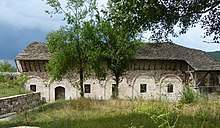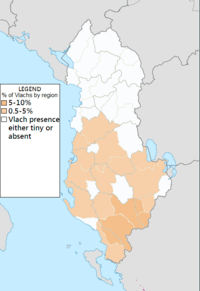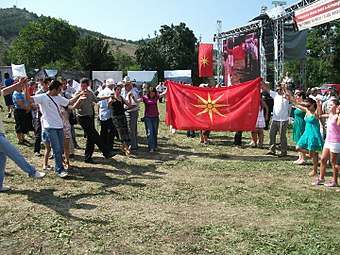Aromanians in Albania
The Aromanians in Albania (Aromanian: Rrãmãnj tu Arbinishii, or Armãnj tu Arbinishii, Albanian: Vllehët në Shqipëri) officially Minoritetu Rrãmãn/Armãn tu Arbinishii, Minoriteti Vllah në Shqipëri, also known as Aromanians (Arumunët), Vllehët, Çobenjtë, Llacifacët, Xacët, or Xinxarët, are an officially recognised ethnic group native in central and south Albania.[1]
 Map of Aromanian settlements in Albania | |
| Total population | |
| 8,812 (2011 census) unofficial estimates count up to 200,000 | |
| Regions with significant populations | |
| Korçë County, Fier County, Gjirokastër County, Elbasan County, Vlorë County, Berat County, Durrës County, Tirana County | |
| Languages | |
| Aromanian (native), Albanian | |
| Religion | |
| Eastern Orthodox Christianity | |
| Related ethnic groups | |
| Aromanians |
Ethnonyms
| Part of a series on |
| Aromanians |
|---|
| By region or country |
| Major settlements |
| Language |
| Religion |
| History |
| Related groups |
The Aromanians in Albania are officially called the Minoriteti Vllah. The local population often refers to them as Vllehë, Çobenjë (from Turkish çoban, "shepherd"), Arumunë, Llacifacë Xacë or Xinxarë.
History
The Aromanians were first recognized at the London Conference of 1912–13 as a minority group within Albania. They fought the Ottoman Empire alongside the Serbians and Greeks during the Balkan Wars.
Historical settlements
Moscopole
The city of Moscopole (Albanian: Voskopojë) was once home to the largest Aromanian population in the world. It was the cultural and commercial center of the Aromanians with a population of over 60,000 people. The city was razed to the ground by Ali Pasha of Ioannina in 1788, causing an exodus of Aromanian people across the Balkans. Many of them ended up in what would become North Macedonia, Albania and Greece. The largest concentration of Aromanians was in the Pelister region of Macedonia, the city of Kruševo and around the Prespa Lakes. The Moscopolitans, or the Moscopoleanji in Aromanian, is one of the largest population of Aromanians today. They speak the Moscopolean dialect of Aromanian and are the descendants of the Moscopoleans in Krusevo (Aromanian: Crushuva, Macedonian: Крушево) are today a fully recognized minority group under the constitutional law of the Republic of Macedonia.
Grabova

Grabova was a medieval town created in the 10th century. Aromanians have left Grabova on several occasions, although the village has never been completely deserted. The first wave of depopulation took place in the 17th century, when Grabova shared the fate of Moscopole and during the inter-war period, starting with 1931, many of Grabovars emigrated to Elbasan and Lushnjë. In 1933, 15 families from the village emigrated to Romania; they initially settled in the Quadrilater and then, in 1940, in the village of Nisipari, Constanța County, from where they moved to the larger nearby towns (Medgidia, Ovidiu, Constanța ) Another important immigration began in 1950, when communist authorities used the craftsmen from Grabova to build the industrial units in Korçë, Pogradec, Gramsh, Elbasan, and Tirana. The people of Grabova speak the Grabovar dialect of Aromanian.
Culture
Music
Religion

Aromanians in Albania are predominantly Orthodox Christians like the rest of Aromanians in the world. In Korçë (arom. Curceau) they have an Aromanian-language church named 'Alju Sutir' (Transfiguration of Jesus), and is the only church in Albania that is preaching in Aromanian language. Before that, they had another church also in Korçë with the same name, build in 1925 and destroyed by an earthquake in 1931.
List of settlements
The Aromanian community in Albania is estimated about 200,000 people, including those who no longer speak the language.[2] Tanner estimates that the community constitutes 2% of the population.[2] In Albania, Aromanian communities inhabit Moscopole, their most famous settlement, the Kolonjë District (where they are concentrated), a quarter of Fier (Aromanian Ferãcã), while Aromanian was taught, as recorded by Tom Winnifrith, at primary schools in Andon Poçi near Gjirokastër (Aromanian Ljurocastru), Shkallë (Aromanian Scarã) near Sarandë, and Borovë near Korçë (Aromanian Curceau) (1987).[3] A Romanian research team concluded in the 1960s that Albanian Aromanians migrated to Tirana, Stan Karbunarë, Skrapar, Pojan, Bilisht and Korçë, and that they inhabited Karaja, Lushnjë, Moscopole, Drenovë and Boboshticë (Aromanian Bubushtitsa).[3]


Central Albania
The Myzeqe (Aromanian: Muzachia) is an area in southwestern-central Albania which encompasses parts of the Fier (Aromanian: Ferãcã), Tirana and Durrës counties. It has a large Aromanian population spread across many villages. The Aromanian inhabitants of Myzeqe are referred to as Muzachiars or Muzachirenji in Aromanian.
Southern Albania
In Southern Albania.
- Berat
- Selenicë
- Ura Vajgurore
- Kotë
- Andon Poçi
- Humelicë
- Palokastër
- Hundëkuq
- Labovë
- Karjan
- Kakoz
- Gjat
- Nokovë
- Mingul
- Këllëz
- Dhoksat
- Qestorat
- Valare
- Vanë
- Stegopul
- Suhë
- Saraqinisht
- Selckë
- Sqepur
- Polican
- Skore
- Ndëran
- Xarrë (arom. Ara)
- Shkallë (arom. Scarã)
- Kardhikaq
- Bajkaj
- Stjar
- Përmet
- Frasher (arom. Farshãr)
- Leshicë
- Badëlonjë
- Biovizhdë
- Çarshovë (arom. Charshova)
- Draçovë
- Hoshevë
- Kosinë
- Kutal
- Vllaho-Psillotarë
- Gërmenj
- Llëngë
- Grabovë e Sipërme (arom. Greãva)
- Niçë (arom. Nicea)
- Shipskë
- Nikolicë
- Dardhë
- Arrëz
Minority status
First the Aromanians were recognized at the London Conference 1912-13 as a minority group until the communist era (1967). From 1967 until 1992 they were known as Albanian people, and from 1992 until 2017 they were known as a cultural and linguistic minority. Since 2017, the Aromanians are an officially recognized ethnic minority.
Education
In the state University of Tirana Aromanian language is present in the Faculty of Foreign Languages.
Media
Aromanian-language media in Albania are RTSH 2, Radio Televizioni Gjirokastra and TV Korça. RTSH 2 broadcasts from Monday to Friday news and programms in Aromanian Language, while the other two only once a week. Beside TV media are also the internet radio RTV Armakedon, newspaper Fratia, magazine Fãrshãrotu and Arumunët/Vllehtë
Notable people from Albania
- Ioannis Chalkeus (1667–1730-40) - scholar and philosopher
- Daniel Moscopolites (1754–1825) - scholar
- Mocioni family (19th c.) - Banking and philanthropist family in Austria-Hungary
- Victor Eftimiu (1889–1972) - poet and playwright
- Aleksandër (Sandër) Prosi (1920–1985) - actor
- Nikolla Zoraqi (1928–1991) - composer
- Jakov Xoxa (1923–1979) - writer
- Aleksandër (Sandër) Prosi (1920–1985) - actor
- Violeta Manushi (1926–2007) - actor
- Nikolla Zoraqi (1928–1991) - composer
- Melpomeni Çobani (1928–2016) - actor
- Margarita Xhepa (1932–) - actor
- Albert Vërria (1936–2015) - actor
- Ndriçim Xhepa (1957–) - actor
- Lindita Theodhori (195?–) - singer
- Parashqevi Simaku (1966–) - singer
- Vasil Trasha (1928–1958) - pilot
- Georgios Sinas (1783–1856) - businessman
- Simon Sinas (1810–1876) - businessman
- Mocioni family (19th c.) - Banking and philanthropist family in Austria-Hungary
- Pilo Peristeri (1909–2009) - Albanian politician of the Albanian party of Labour
- Rita Marko (1920–2018) - Chairman of the Parliament of Albania
- Nektarios Terpos (end 17th–18th century) priest and author
- Theodore Kavalliotis (1718–1789) - priest and teacher
- Theoharis Trasha (1985–) - weightlifter
- Theodhor Gërnjoti (1943–2010) - boxer
- Aurel Plasari (1956–) - lecturer, scholar, writer, translator and professor
- Gert Trasha (1988–) - weightlifter
- Keidi Bare (1997–) - football player
Gallery
 National Aromanian festival in Moscopole, 15 August 2010
National Aromanian festival in Moscopole, 15 August 2010 Sign in Aromanian language in Moscopole
Sign in Aromanian language in Moscopole Moscopole at 1742
Moscopole at 1742
See also
- Aromanians in Greece
- Aromanians in North Macedonia
- Aromanians in Serbia
- Moscopole
References
- Project, Joshua. "Aromanian in Albania". Retrieved 2017-08-29.
- Tanner 2004, p. 209.
- Winnifrith 1987, p. 35.
External links
- "State Committee of Minorities" (in Albanian).